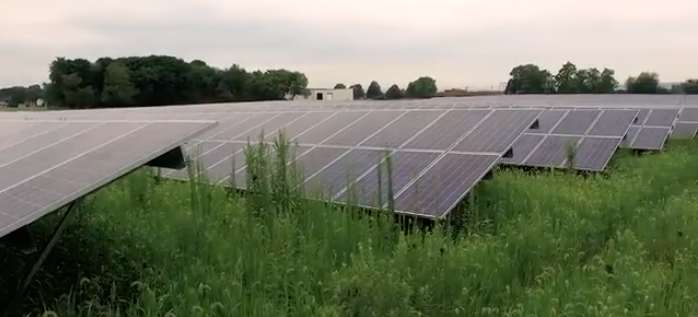On Track to Carbon Neutral 2020 with Solar Panels
Dickinson will install a new solar panel field west of College Park by December, keeping the college on track to be carbon neutral by 2020.
Construction began on 12,400 solar panels on the twelve-acre plot of land in February 2018 as part of a power purchasing agreement with Tesla, Inc., a California-based corporation that manufactures solar panels.
The installation will eliminate 1,800 metric tons of carbon and produce about five million Kilowatt-hours of energy each year. Dickinson College currently uses 18 million Kilowatt-hours of energy per year. Therefore, the panels will produce more than a quarter of the total energy consumed by the college, said Ken Shultes, associate vice president for sustainability and facilities planning.
The installation will also allow the college to reduce carbon emissions by 25 percent from 2008 levels. According to Shultes, “the big array… will help reduce emissions by about 10 percent. It’s a big piece of that 25 percent [goal].”
As part of the agreement, Tesla buys and installs the panels and then sells the electricity produced to Dickinson. The agreement will allow the college to purchase the power from Tesla at a fixed price for 25 years, with the cost rising to match inflation.
“One of the nice advantages of a power purchasing agreement is that we know exactly what we’re going to pay for the electricity generated by those panels,” said Shultes. “Tesla has to maintain the panels over the 25 year contract, so there’s very little upfront cost.” The panels will be operational by this December.
Dickinson is responsible for maintaining the land itself, said Shultes. The college farm will periodically send sheep to graze around the panels to control the grass and eliminate weeds.
In 2008, when Dickinson began its push for carbon neutrality, the college emitted 19,000 metric tons of carbon that year. Shultes said now the college emits about 16,300 metric tons of carbon in a year, before the addition of the solar panel field. Dickinson reduced emissions from 19,000 metric tons to 16,300 tons through a variety of climate action plan projects on campus.
Lighting projects in the last year have converted 95 percent of the lights at Dickinson to LED and eliminated 750 metric tons of carbon, said Shultes. Dickinson also has 10 solar installations on campus, and the college farm receives 50 percent of its power from solar arrays at the farm.
Still, Shultes said “there are definitely more opportunities for solar on campus… the biggest opportunity for more ground mount systems would be to put solar [trellises] in parking lots.” Those trellises would be costly, he said, so the next best option would be to install panels on buildings.
Other ongoing projects to reduce carbon emissions include the use of sensors to save electricity and maintenance to make buildings more efficient through ongoing repairs and replacements.
To learn more about sustainability on campus, listen to Shultes’ Sustainability Jam Hour on WDCV radio from 10 to 11 a.m. on Mondays.






